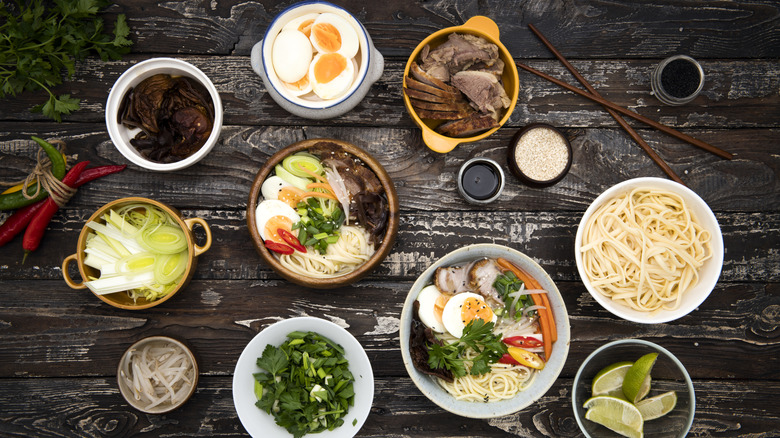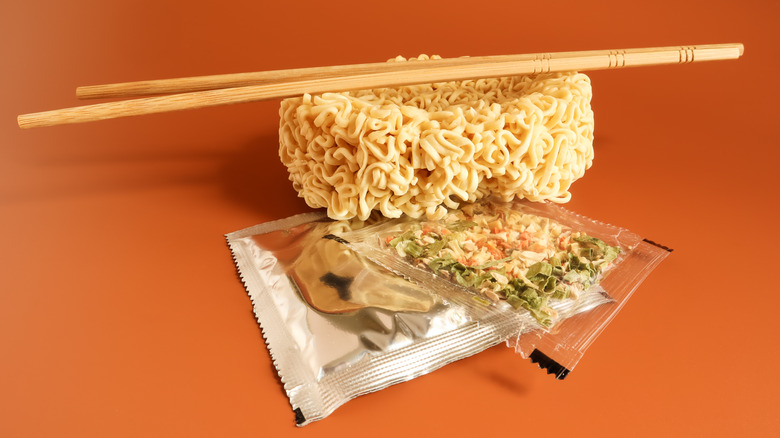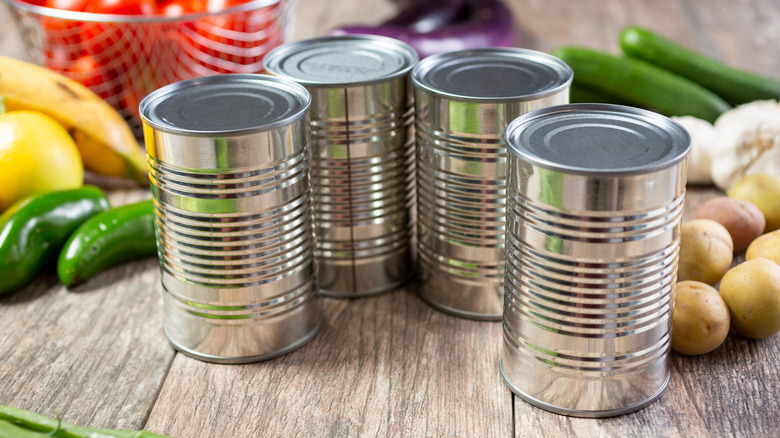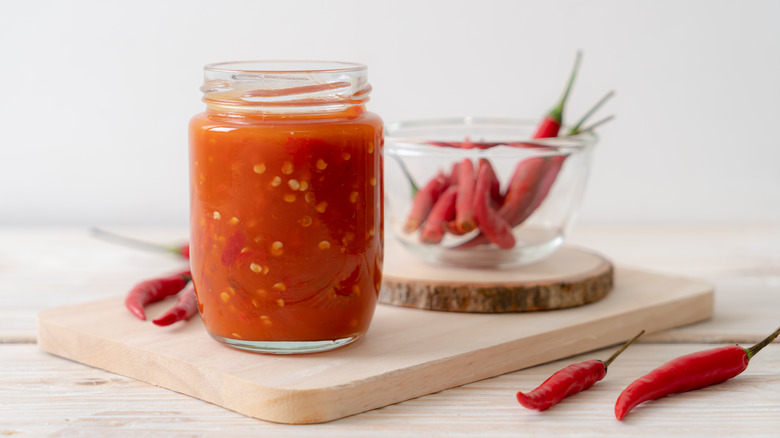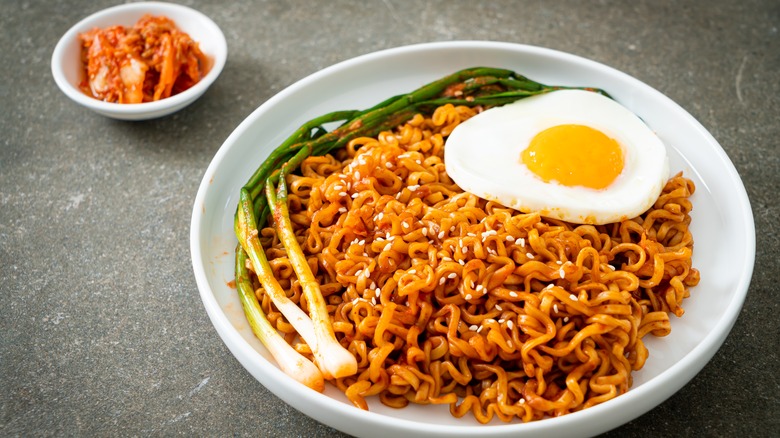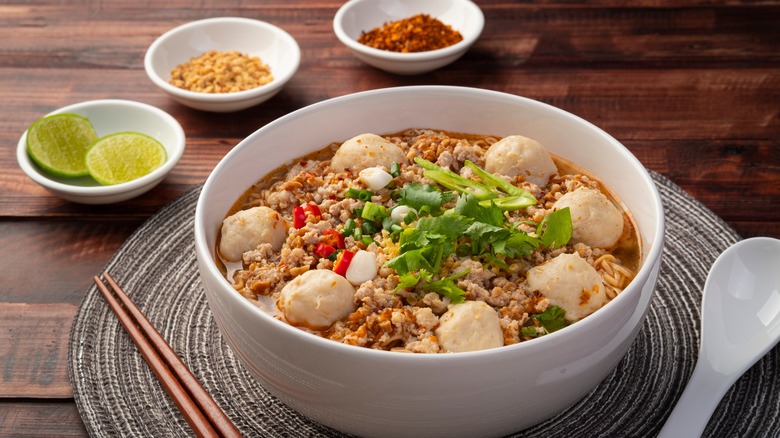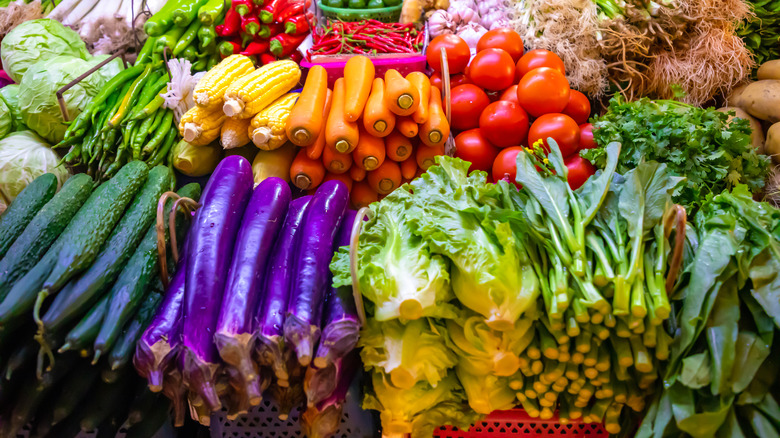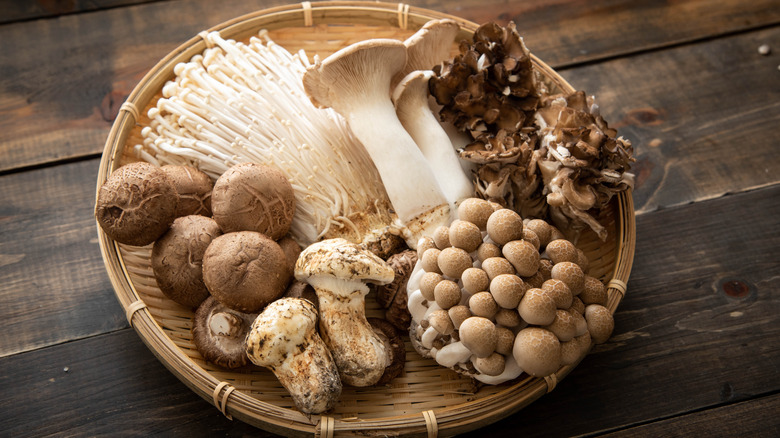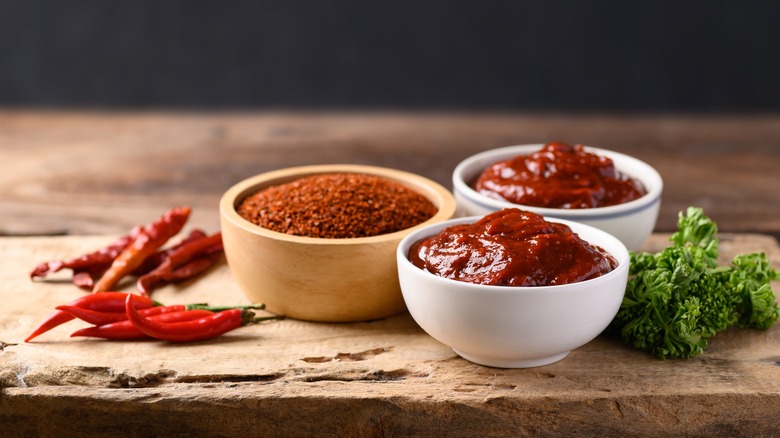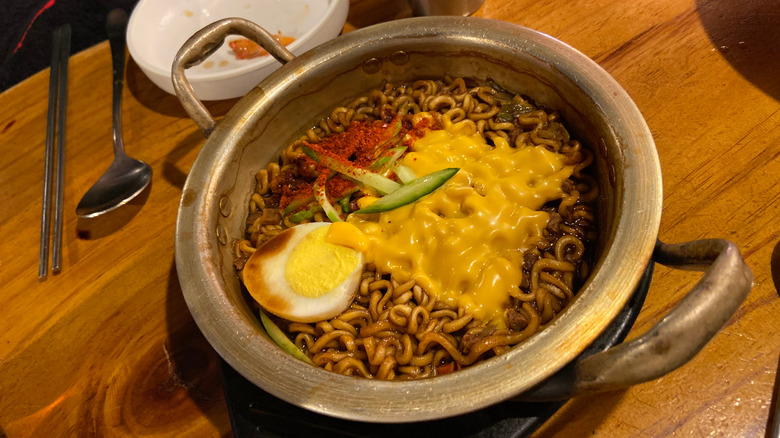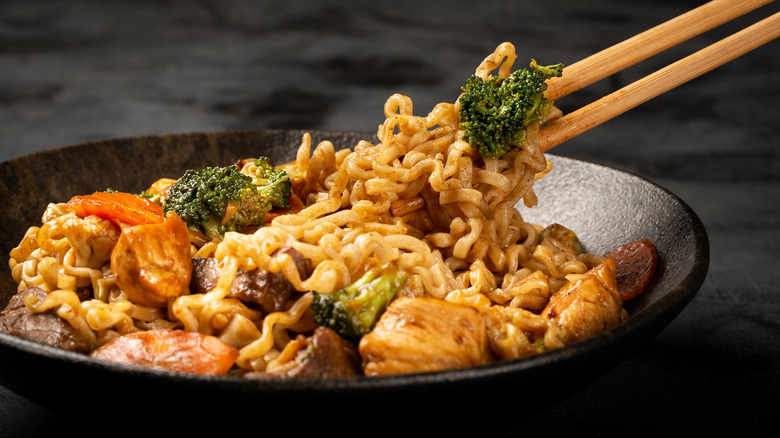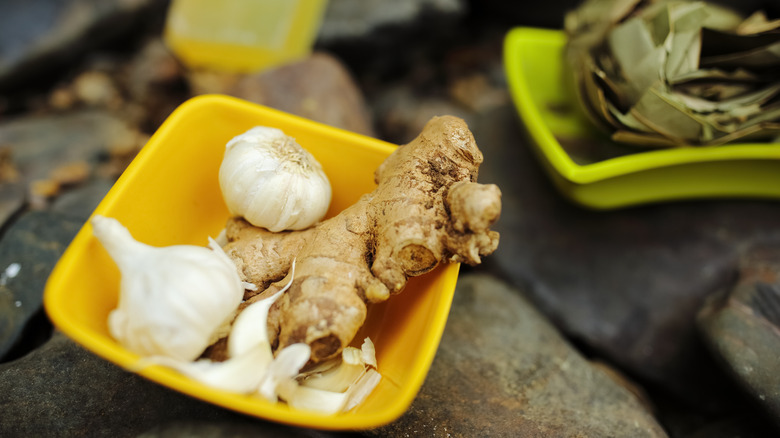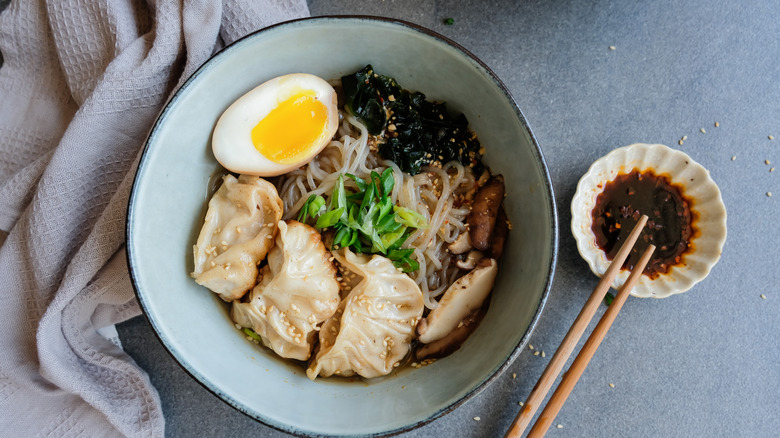75+ Toppings To Turn Instant Ramen Into A Restaurant-Worthy Bowl
We all know instant ramen — the staple meal of college students served either as a soup in a cup or a packet of dry noodles with seasonings. But, instant ramen can be so much more than that. With a few changes, basic noodle packets can become restaurant-worthy meals. You might even have many of these toppings in your pantry already!
Ramen first originated in China, and Japan has taken the seemingly simple noodle soup and turned it into an art form. In Japan, ramen noodle restaurants are found throughout the country. Ramen is as prolific as your favorite green mermaid coffee stop in America, with there being an estimated 25,000 ramen restaurants throughout Japan.
There are four traditional types of ramen — shoyu ("soy sauce"), shio ("salt"), miso ("soybean paste"), and tonkotsu ("pork bone") — but there are almost infinite ways to customize your dish. We've got a plethora of ideas to show you how to "soup" up your instant ramen into a beautiful, tasty meal. You'll find that many of our ideas are untraditional, but they are all tasty!
Ditch the packet
Maybe you're thinking, "Hey, this is supposed to be about toppings." Your broth actually is a topping and creates a base for a restaurant-quality dish. One of the easiest ways to elevate your ramen is to throw away the seasonings that are included in your store-bought packet and instead make your own broths for your noodles. Try substituting water with broth, bouillon, or shio tare (stock). Make life easier and create miso broth using miso from a squirt bottle. Add your dry noodles to broth (or water), then transfer to your bowl after they're cooked. You can also simmer your vegetables in broth to add more flavor.
Wherever you can add flavors, do it! If you're adding broth to make a soup-style ramen, remember that the broth will continue to cook your noodles a bit more even after they're off of the heat. After you've transferred your noodles, gently pour your broth around the inside edges of your bowl if you're making soup-style ramen. Now your broth is a topping, see?
Canned soup
A quick and easy way to add flavor is to put canned soups in your broth. A simple can of pre-made soup can change the consistency of your ramen and amp up your flavor profiles. Substituting half of your broth or water with a cream-based soup will make your ramen broth rich and thick.
For an even more decadent sauce, ditch the water entirely and use the full can. Add a can of condensed soup to your saucepan, add a splash of milk or cream to thin the sauce, then add your cooked noodles. The creamy texture mimics a Tonkotsu-style ramen without having to take the time to boil down pork bones for hours.
0Try different varieties of soups, such as cream of jalapeño or poblano pepper, to take your tastebuds south of the border. Visit the U.S.'s east coast and make faux penne a la vodka using shrimp and lobster bisques. Get creative! There is a wealth of soup flavor options in your local grocery store to suit various flavors and budgets.
Simple sauces, big impact
One of the quickest, simplest methods to top off your ramen is by adding a few dashes of your favorite shoyu (soy sauce), or stirring in some coconut milk. Splash a few drops of toasted sesame oil into your broth to add a nutty taste. Stir in a few spoonfuls of hoisin with or without garlic to add flavor and color to your ramen's broth.
Soy sauce is the most common of our sauces, and it can be so much more than just a topping! You can also use it to marinate your proteins or veggies or as a dip for your sides. This traditional condiment sometimes gets a bad rap for being high in sodium, so try low-sodium versions or alternatives, such as amino acids or tamari. Amino acids and tamari do not contain wheat (as soy sauce does), so they are gluten free. Still, make sure to read your labels, as brands differ. For a different flavor, ship up some Thai-inspired peanut sauce and toss with drained noodles.
One of our personal favorite sauces is sweet chili sauce. This Thai sauce is mildly sweet and spicy. Add a few dollops to your ramen, then use it as a dipping sauce for potstickers, crab rangoons, or whatever sides you have. Give Japanese tare sauce a try for something tangy and tasty as a finishing touch or as a dipping sauce.
Vinegar — more than just for pickles
You won't find yourself in a pickle using vinegar as a topping for your ramen. While you may pucker at the thought of splashing white vinegar into your soup, vinegar is actually a staple in making ramen. Most ramen recipes will call for rice vinegar or rice wine, the latter also known as mirin. While there are differences between the rice vinegar and rice wine, both are a useful addition to keep on hand in your pantry to use in stir fries, to elevate your ramen for broth, or to cook your proteins.
A splash of hot pepper vinegar can work as a dupe to create your own hot and sour soup. Grab that white vinegar and you can make your own by adding chilies! Use your noodles raw and turn them into a cold salad using white vinegar as the base of your dressing. If white vinegar is too intense, apple cider vinegar works great too with cold ramen salads.
We have eggs-actly what you need
No restaurant-quality ramen dish would be complete without adding eggs. The addition of egg to your broth makes for a more flavorful, richer timbre if you're using a soup. Adding creaminess to a ramen dish without broth is also simple: Just gently fold scrambled eggs into your drained noodles to elevate your meal.
One of the most traditional ramen eggs is a soft-boiled egg, also called a jammy egg in Japanese-style ramen. The soft-boiled Japanese ramen egg can also be a great addition for meal prepping because you can make these eggs a few days in advance, refrigerate and use when ready. These eggs are a delicious topping for cold or hot ramen dishes.
Soy sauce–marinated eggs (called ajitsuke tamago, or "seasoned egg") are another delicious, soft boiled–egg topping. Even further, try soy sauce–cured egg yolks in your noodles and create a velvety sauce when stirred together. A poached egg gently added to the top of your ramen is beautiful and tastes indulgent. If you really want to take your eggs up a notch, use quail or duck eggs in your ramen.
This little ramen ate pork
Homer Simpson once said that pork came from a "wonderful, magical animal." In the world of ramen toppings, Homer was absolutely correct. Pork has a variety of preparation methods, each of which can have a place in ramen: bacon, pork belly (this is our personal favorite to make), or boiled ham hocks are all amazing options for a rich-tasting broth.
In classic Tonkotsu ramen, pork bones are boiled for hours, creating a cloudy, rich, flavorful broth. If you want to use marinated pork but are short on time, many grocery stores sell pre-seasoned pork loins. Cook as directed, then slice and add to your ramen dish. No one will ever know! Try pulled pork or sliced andouille sausage for a different flavor profile.
Crispy bacon crumbles or prosciutto are two of the tastiest ramen toppings. Using prosciutto instantly elevates your ramen to truly restaurant worthy. Making scallops, bacon, and eggs leads to a dish that is both easy and elevated. A marinated pork called either chashu or nibuta in Japan is one of the most recognized ramen toppings, and is one of the most delicious. The caramelized, soy sauce–glazed pork belly will have you slurping your ramen with reckless abandonment. Ground pork meatballs with lemongrass can also make your ramen truly shine.
Gotta get that protein!
Although we've mentioned various pork preparations to top your ramen, there is still a whole world of other proteins to use as toppings. Ground turkey browned in a skillet then stirred into either your broth or noodles adds healthy, low-fat protein. Toss shredded chicken into almost any ramen dish or use pre-seasoned, frozen grilled chicken strips as a topping.
With the addition of meat, you can alter your ramen and make stir fry. Reduce your broth and add fresh or frozen broccoli and snow peas for added color and crunch. Ground beef adds similar flavors as stew meat but reduces time and expenses. Grab a flank steak and a couple cans of lager for a delicious, beer-based ramen to eat during the hot summer days.
For a meatless variation, tofu is an excellent, go-to option. A half cup of firm tofu contains 21.8 grams of protein but only 11 grams of fat, making it an excellent, low-fat alternative. You can even make your own tofu! Tempeh is another plant-based option. Whereas tofu takes on whatever flavors you cook it with, tempeh has a nutty flavor of its own. It's crispy on the outside with a softer center, thus giving a textural contrast to ramen noodles.
Eat your greens
Adding vegetables customizes your ramen and increases nutritional value! Mixing in baby bok choy, yu choy (a Chinese leafy green), chopped napa cabbage, or shredded green cabbage brings composition and flavor. Diced celery, frozen peas and carrots, collard greens, snow peas, or Chinese broccoli are all enticing options, too.
Cooked, shelled edamame and peanuts not only add color but also protein. Edamame has 11 grams of protein and the peanuts pack 26 grams per 100-gram serving! Have a little fun and add spiralized zucchini noodles to your ramen. Grab a jar of kimchi or, better yet, make your own spicy kimchi. For a little spicy crunch, add daikon radish to your dish.
Toss in frozen sweet corn as the ramen is cooking, or fresh corn as a topping. Try topping drained noodles with elote corn for a creamy, Mexican taste–inspired dish. Toss on sliced jalapeños to complete your south-of-the-border flavors.
Sprinkle on toasted sesame seeds for crunch, and nestle some menma (fermented bamboo shoots) or chopped scallions for color. How about topping off your ramen with a few slices of avocado alongside your eggs? Try out avocado tempura as a side or topping, as well.
Add umami flavor through mushrooms
Many recognize the four main flavor groups: sweet, salty, bitter, and sour. But, have you eaten something you feel doesn't fit those four categories? The word you were looking for is "umami," or "the fifth flavor." While umami is difficult to describe, Japan has known about the flavor for over a century. The word umami translates to "tastiness" or "deliciousness."
Steaks, seafood (such as bonito or sardines), and aged cheese all provide umami flavors. The most commonly known umami tastes are found in dried mushrooms like shiitake or morels. All of these foods make incredible toppings! Pickled shiitake mushrooms, enoki mushrooms, and shimeji are all amazing as toppings or used in your broth. Oyster or trumpet mushrooms make a textural substitute for meat while adding umami flavors.
It's easy to create other umami profiles, too. Keep your pantry stocked with a jar of umami seasoning blend. You can sprinkle it on almost anything savory. For another quick topping, sprinkle a baggie of furikake, also known as bonito flakes. Have a little fun with your furikake and grab some Hello Kitty– or Pokemon-themed seasoning packets! You can also toss a packet of furikake into other soups like chicken and rice to amp up that umami flavoring.
Get spicy
One of the yummiest ways to elevate ramen is through spicy toppings. We don't mean that you have to burn your taste buds off to add incredible flavor, but a little spice can go a long way.
Most people are familiar with sriracha as a great go-to for an added kick. Try sriracha's lesser-known siblings: less intense, chunky garlic chile paste, or Sambal Oelek, made from only chilis. You can also find sriracha seasoning in powder form so that you can sprinkle on everything. Try Korean Pepper Powder or Gochugaru, the seasoning used to make kimchi, as toppings, too. Chili crisp is another great topping that adds a little crunch with your spice.
You may want to add gochujang, a paste made from fermented red chili powder, soybeans, barley malt powder, salt, and glutinous rice. Gochujang is a blend of sweet and spicy flavors and is most commonly found in Korean cooking. Stir in a spoonful to kick up your broth.
Thai curry paste is another easy way to add punch to your ramen. Thai curries vary between red (made from red chilis and holy-moly hot), yellow (turmeric-laced), green (the mildest and super yummy if high levels of heat are too much when it comes to spicy level), and peanutty Massaman. Give Togarashi spice blend a sprinkle to add spicy, salty, and sweet flavors. Benishoga, or pickled ginger, most commonly seen as an addition to sushi, also makes a tangy touch to your ramen.
Under the sea
We would be remiss if we left out toppings from under the sea. Two of the most popular ramen toppings are nori and kombu, both forms of dried edible seaweed. Slice sheets into small rectangles and place in your bowl as a garnish. Once the nori or kombu absorbs your broth, it's a yummy bite.
One of the tastiest additions for ramen is seafood. Toss in a handful of cooked shrimp, imitation crab, or, if you're feeling fancy, some real crab meat or lobster. Sardines bring umami flavor to your dish. To make a truly restaurant-worthy ramen, sear scallops for a decedent topping. The most classic and cutest seafood topping is naruto, which are cute pink and white swirled fishcakes — not the anime character.
Fish sauce, made from either krill or fish that has been salted and fermented, is a great topping. Be careful, though: Fish sauce is super salty, and a little goes a long way. Another salty addition to your ramen can be seaweed. Its bright-green, brine-y goodness adds flavor, color, and a little crunch to your ramen dish.
Say cheese
We don't mean to sound cheesy, but American cheese slices make a fabulous ramen topping. American cheese slices have actually been served in Korean restaurants since the Korean War. Restaurateurs used the cheese to minimize the spiciness of their dishes for American soldiers. Those lowly cheese slices actually can make ramen great!
If you don't believe us, Chef Roy Choi, considered one of the pioneers of the food truck phenomenon through Kogi BBQ, shocked people by adding sliced American cheese to his ramen. While you may not find creamy cheesy ramen in a fancier restaurant, your kids will thank you for topping your ramen with melty cheese sauce. Head to your pantry and grab a can of cheese soup, mix in milk or cream to make creamy ramen that's tastier than the blue box stuff. Experiment with different melty cheeses! Gently crack an egg into your drained noodles, stir until cooked but not scrambled, top with parmesan cheese so it melts and you've got ramen carbonara!
For different flavors, try cream cheese, which melts beautifully and adds a slight tang. Top your noodles with cotija or feta for a saltier taste. Cotija melts a bit better than feta, but both are more suitable as a topping.
Go international
One of the best things about instant ramen is that the naked noodles are like a blank canvas for creativity. If we haven't already given you enough inspiration, let's go international with our flavors! Try Saimin, Hawaii's ramen noodle soup. Top your noodles with pineapple and toasted spam cubes. Add coconut milk and chicken to your broth for Thai-inspired tom kha ramen or drain your noodles, add vegetables and a peanut sauce for easy ramen Pad Thai.
You can create a Vietnamese-inspired dish if you use Tonkotsu broth and make a faux pho. Traditional pho soup takes hours to create the depth of flavor but you can make an adequate substitute in short order. Top your ramen with crunchy bean sprouts, bamboo shoots, and sliced jalapeños to create Vietnamese-inspired flavors. The origins of pho point to the dish being from Vietnam, but there is evidence the soup originated in France from a beef and vegetable stew called "pot-au-feu." Blend culture and history with French Onion Pho. Topped with toasted sourdough bread and cheese, this dish will transport your taste buds.
Amp up your aromatics
Aromatics are the heavy lifters of flavor in most cooking, but what are they? Aromatics release flavor and moisture, infusing your noodles, liquids, or proteins with their flavors. These humble ingredients are the basis for stocks, broths, to create flavor. Mirepoix, a mixture of chopped onions, carrots, and celery slowly cooked in oil or butter is a classic example and creates a gorgeous base for your ramen. Liquid Gold, created by Chef Joel and Rachel of Flip Eats, is a non-spicy garlic crisp that adds warmth to your ramen but isn't spicy.
In ramen, ginger is another essential aromatic. Benishoga, or "pickled ginger," most commonly seen as an addition to sushi, also makes a tangy touch to your ramen. Pickled ginger makes a great topping that is good for you! You can also substitute ginger in place of onions or garlic, making it an extremely versatile ingredient.
Chocolate is also considered aromatic and can be used to heighten umami flavors in mushrooms or beef. Chocolate pairs well in a beef broth or even as a noodle flavor. You can even grab your favorite chocolate bar, break it into pieces and pick them up with your chopsticks like any other ramen topping. However, to really get a kick from your chocolate, stir it into your broth and allow the pieces to melt. The chocolate apparently adds a sweetness with a pleasantly sharp aftertaste.
Holy ramen sidekicks, Batman!
In almost any comic book, the sidekick is usually not as important as the main character and is considered secondary at best. However, the sidekick elevates the main dish, allowing the main dish to shine through. A great sidekick can take your dish to a whole other level of flavors and textures. In your ramen, what was a humble sidekick can take on an essential role when used as toppings.
Top off your ramen with dumplings or wontons. You can use frozen versions or make your own. Potstickers (another type of dumpling) are also tasty toppings or side dishes. Gyoza, a variety of potsticker, is another tasty option to toss into your ramen. While gyoza, potstickers, and dumplings are all considered dumplings, their various shapes and fillings differentiates each.
On a chilled or drained ramen, add some spice and crunch. Top your ramen with a cool, chili cucumber salad or Japanese potato salad. Add more protein and color by topping your ramen with gorgeous skewered chicken. Skewers, called yakatori in Japan, are both tasty and eye catching and will truly elevate your dish.

